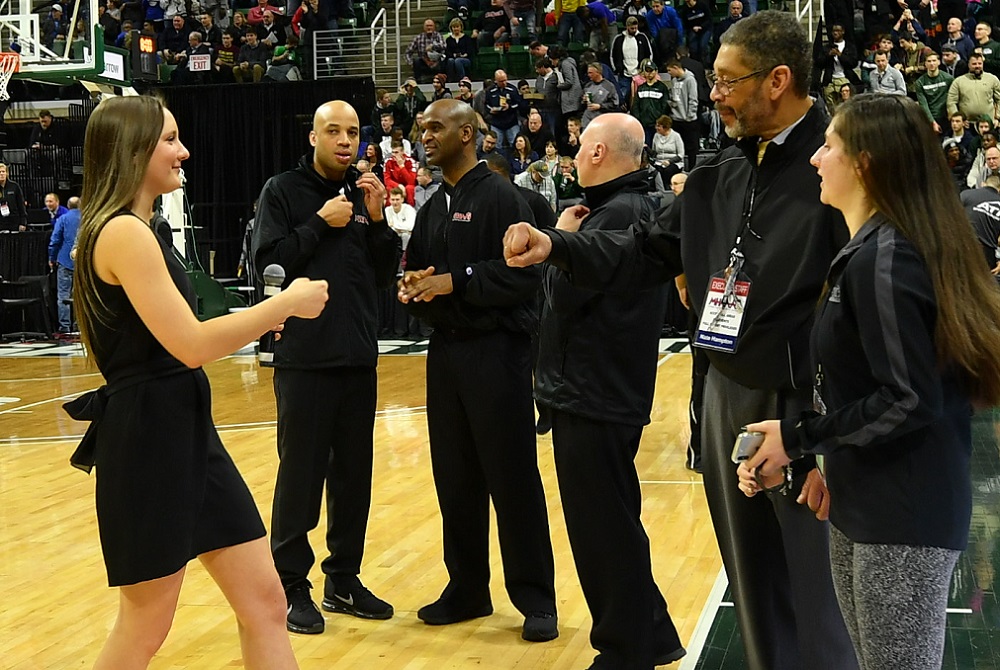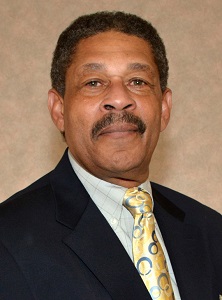
MHSAA's Hampton Retires After Half-Century of School Sports Service
By
Geoff Kimmerly
MHSAA.com senior editor
July 30, 2021
Longtime assistant director Nate Hampton has retired after 32 years on staff with the Michigan High School Athletic Association and 50 serving in education and educational athletics.
After 18 years working in schools, Hampton began his tenure as part of the MHSAA staff on Sept. 5, 1989, and his impact has been felt across many sports and subjects over the decades. He has served as the MHSAA’s administrator for the majority of its most-played sports – football, girls and boys basketball and girls & boys track and field – as well as serving as staff liaison to the MHSAA Athletic Equity Committee and Upper Peninsula Athletic Committee.
His longtime guidance will continue to be felt nationally as well. Hampton served multiple terms on committees for the National Federation of State High School Associations (NFHS), including the football and basketball rules committees.
 “Nate has been a giant in high school athletics in Michigan over half a century and through eras that have seen the shaping of school sports as they’re played today,” MHSAA Executive Director Mark Uyl said. “The knowledge and leadership he’s provided locally, statewide and nationally has benefitted thousands of athletes and their families, both in how educational athletics are administered on the field and off.”
“Nate has been a giant in high school athletics in Michigan over half a century and through eras that have seen the shaping of school sports as they’re played today,” MHSAA Executive Director Mark Uyl said. “The knowledge and leadership he’s provided locally, statewide and nationally has benefitted thousands of athletes and their families, both in how educational athletics are administered on the field and off.”
Hampton received the Michigan High School Coaches Association’s Jack Johnson Distinguished Service Award in 2020 for his many contributions. He previously received a Citation from the NFHS in 2011 and also has been recognized by several other Michigan organizations including the Basketball Coaches Association of Michigan, Michigan Interscholastic Athletic Administrators Association and Michigan Interscholastic Track Coaches Association.
Hampton is a 1966 graduate of Detroit Eastern High School. He went on to earn his bachelor’s degree from Morgan State University (Md.) and a master’s from Eastern Michigan University.
Prior to joining the MHSAA staff, Hampton taught and coached one school year at Dearborn Heights Robichaud High School followed by 15 years total with the Highland Park School District where he coached three sports, taught and served as athletic director during his tenure. In 1987, Hampton began as supervisor of athletics and physical education for the Saginaw Public School District, where he was responsible for all phases of the athletic programs for both high schools, five middle schools and 24 elementary schools.
Hampton also served on the MHSAA Representative Council prior to joining the staff.
The majority of Hampton’s duties have been assumed by recently-hired assistant director William McKoy, who joined the staff earlier this month after previously serving as athletic director at Romulus Summit Academy North.
PHOTO: MHSAA assistant director Nate Hampton, second from right, thanks a national anthem soloist during the 2019 Boys Basketball Finals at Breslin Center.

Rep Council Wrap-Up: Winter 2018
March 28, 2018
By Geoff Kimmerly
Second Half editor
With a number of important topics filling the agenda for its Spring Meeting this May, the Representative Council of the Michigan High School Athletic Association prepared for a number of possible votes by receiving and requesting additional information during its annual Winter Meeting on March 23 in East Lansing.
The Winter Meeting frequently serves as an opportunity for the Council to discuss items expected to come up for action at its final meeting of the school year, scheduled for May 6-7. Since June of 2017, the MHSAA has been pushing several projects forward – with work on the transfer rule and junior high/middle school sports receiving the most emphasis.
Addressing the chronically troubling nature of transfers in school sports, the MHSAA has facilitated nine months of discussions with leagues and administrative groups across the state to develop a proposal that would make the transfer rule sport-specific – that is, a rule that bases current eligibility on the sports an athlete has participated in in the past. The proposed new rule would make transferring students ineligible at a new school in the sports they played the previous year at their old school. However, transfer students would be immediately eligible in any sport they didn’t participate in the previous school year. A list of exceptions, including a change of residence, would still allow for transferring students to become eligible in all sports.
The Council discussed how support for this potential transfer rule change has grown, and suggested the MHSAA send further explanation of the proposal to school superintendents and principals before the meeting in May.
“Since last summer, there has been membership-wide discussion of proposals that pursue the elusive goal of adopting a transfer rule that is simpler and easier to understand and, therefore, more consistently enforced,” MHSAA Executive Director John E. “Jack” Roberts said. “There appears to be broad consensus that we are on the right path.
“If adopted by the Council in May, the full effect of the changes would not be felt until the 2019-20 school year. What sports are actually played by a student during 2018-19 would determine that student’s eligibility after a transfer for 2019-20.”
The Council also is continuing work on a number of efforts related to the MHSAA’s growing presence at the junior high and middle school level. Under consideration is a proposal increasing the number of contests permitted within the maximum 13-week seasons for several sports, and another proposal relaxing or eliminating the Limited Team Membership regulation for most sports at that level. The Council also is considering expanding the MHSAA’s role as a presenting sponsor at events involving junior high/middle school students.
MHSAA membership at the junior high/middle school level has increased by more than 100 schools – nearly 14 percent – and nearly 70 percent of 800 member junior high/middle schools have begun accommodating 6th-graders in their programs since the MHSAA’s Constitution was amended in 2015 to allow 6th-graders to be included.
“The emphasis on policies and programs related to 6th-, 7th- and 8th-graders is essential if sports at the high school level will remain relevant to students and useful to schools which are trying to engage youth in 21st-century learning,” Roberts said. “We’ve also put many policies under a microscope to see if they can be modified to respond to our customers’ desires for more competition at the 6th- through 8th-grade levels while remaining faithful to our mission of providing these younger student-athletes the opportunity to sample sports and develop new interests and skills.”
A number of other topics were discussed during the Winter Meeting in advance of actions that could take place in May or at the Council’s Fall Meeting in December:
• The Council is considering two leading options for setting the girls and boys basketball regular-season and MHSAA tournament schedules after the 2018-19 season. For 2018-19, for the first time, the boys and girls seasons will flip start and end dates, with the boys starting and ending their season first. This will be done to adjust to the availability of Michigan State University’s Breslin Center to host the boys Semifinals and Finals. For 2018-19, no other arena available is large enough to accommodate the crowd that traditionally attends the final games of the boys postseason.
One option for 2019-20 and possibly beyond includes continuing the current strategy of using multiple sites for Semifinals and Finals weekends while accommodating Breslin (or another largest arena’s) availability – for example, this year’s Boys Semifinals and Finals were played at Breslin, while the Girls Semifinals and Finals were played at Calvin College’s Van Noord Arena because Breslin was not available for the girls weekend. (Breslin and Van Noord will be used for the 2019 Semifinals and Finals weekends as well, again to accommodate Breslin’s availability.) The second option would put the girls and boys tournament schedules over the same three-week period and use the largest available arena to host games on only two days; Semifinals would be played at various sites for both genders, with all four girls and boys championship games played at the largest arena during one weekend.
• Also in girls and boys basketball, the Council will consider possibilities for seeding the top two teams in geographically-determined Districts. MHSAA staff have created plans for possible implementation as requested by the Council at its May 2017 meeting.
• In football, the Council is considering options to assist 8-player football schools with their regular-season scheduling.
“While transfers and junior high/middle school programs are fundamentally more important than single sport issues, we have an eye on several that will generate significant interest,” Roberts said. “Schools which sponsor 8-player football will be receiving plans to assist their scheduling of regular-season games, and they will be asked to provide reactions through an online survey during April.
“Basketball continues to have two issues which have more public interest than genuine importance. One – the boys and girls tournament schedule and championship venue after 2019 – is moving toward a vote in December. The other – limited seeding of boys and girls District tournaments – is scheduled for action in May.”
The Council also talked about ways of involving more junior high/middle school students and at more grade levels, and what possible new high school sports might draw students with a wider variety of interests and abilities. There also was discussion on how eligibility and transfer rules are applied to boarding school students and what modifications would promote competitive equity between boarding schools and both public and nonpublic schools.
The Representative Council is the legislative body of the MHSAA. All but five members are elected by member schools. Four members are appointed by the Council to facilitate representation of females and minorities, and the 19th position is occupied by the Superintendent of Public Instruction or designee.
The MHSAA is a private, not-for-profit corporation of voluntary membership by more than 1,500 public and private senior high schools and junior high/middle schools which exists to develop common rules for athletic eligibility and competition. No government funds or tax dollars support the MHSAA, which was the first such association nationally to not accept membership dues or tournament entry fees from schools. Member schools which enforce these rules are permitted to participate in MHSAA tournaments, which attract more than 1.4 million spectators each year.

